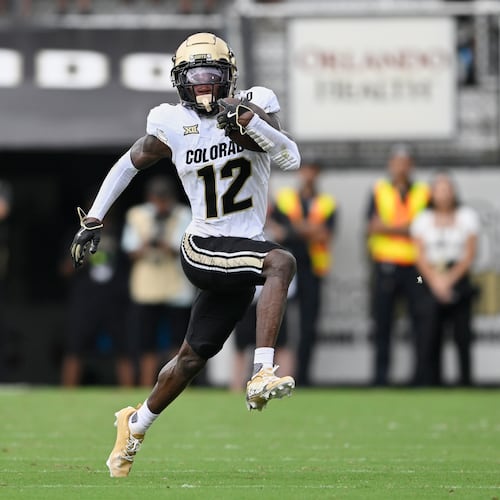Steve Robinson’s legacy at Chick-fil-A may be cows and college football.
After more than 30 years with the company – years in which he led the development of the now-famous cow campaign, a partnership with the Peach Bowl that saw Chick-fil-A experience growth in sales and stores and the games one of the premier events in the sport, and saw him help in bringing the College Football Hall of Fame to Atlanta – Robinson will transition from his role as vice president and chief marketing officer into an advisory role with the company.
Robinson shared what he saw in the sport and the bovines in an interview ahead of this week’s Chick-fil-A Peach Bowl between No. 6 TCU and No. 9 Ole Miss at the Georgia Dome. In 2016 the bowl will host one of the semifinals in the playoff, one of four times over the next 12 years the game will have that honor. In some cases, the questions and his answers have been edited for brevity and clarity.
Q: Why college football and Chick-fil-A?
A: That’s an easy question with a lot of history.
Let me unpack it.
Back in 1995 we had been building free-standing street stores for 10 years. Our (annual) sales were up to $500 million but two-thirds (of the stores) were still in the Southeast. Coincidentally, they fit quite well in the footprint of the ACC and the SEC.
We had an opportunity in December 1995 to go to the Peach Bowl when Kentucky played Clemson. I made the primary observation that the bowl had a great contract with two conferences, the Georgia Dome and college football and no title sponsor.
My wife said, “Why don’t you guys consider doing it?”
I said, “Sweetheart, I think you are right.”
I chose to pursue it, discussed it with leadership team (at Chick-fil-A) and they loved it.
There are several reasons why:
College football fans are great fit with Chick-fil-A;
College football tends to be a multi-generational family sport. There is a lot of passion that goes with it. Love being associated with that.
It’s a great fit geographically to be involved with the bowl.
Our media package was strictly around the game. We didn’t have the store presence or money to do more. At that point all of our marketing was at the store level and some market level.
In 1996 we unveiled the cow campaign which was principally through billboards. The Chick-fil-A Peach Bowl was the first platform to unveil the cows nationally and one of our first ventures with the cows creatively on television.
We know the numbers from data that college football fans are 40 percent more likely to eat with us than normal fast-food consumers. That percentage is even higher for those who attend games. It’s a great fit.
It was around 2000-01 we did our first year-round media package with ESPN. Either that year or close to it we did our first football program with CBS. We’ve grown with the game.
In ’05, we negotiated with the bowl to change the name to the Chick-fil-A Peach Bowl. Two reasons: stronger association with Chick-fil-A, and we were interested to invest in more with the bowl for the reserves so if the bowl ever had an opportunity to invest in the playoff our contribution to the bowl would allow them to do that.
A year ago the board agreed to pursue the college football playoff. Independent of that we had to pursue an agreement to become rights holders for the name of the game.
The bowl did their deal with the playoff and we did our deal with ESPN. It has resulted in not only retaining the partnerships with Peach Bowl going into our 18th year but has resulted in our investment with ESPN going up substantially. To say we are invested in college football is an understatement.
We have grown with the game. This year will top sales of $5.6 billion. In 2020, we should have a restaurant in all of the continental states in the U.S.
(It’s) One thing we have been able to do nationally to support our restaurants. Our role is to provide the national air cover and we have found college football the one place we can afford to do it and we get a great return on that investment.
We’ve been incredibly pleased with the partnership with the game, with Gary Stokan and his staff, the CFP and ESPN. Very pleased with how they’ve partnered with us.
Q: The cows are famous, they are in the advertising half of fame. Can you share what the runners up for campaign ideas were?
A: That’s true. They are also going to go into the Smithsonian.
It was about a year into our relationship with The Richards Group. At that point we were only doing billboards, not doing any broadcast.
A year into it they brought us some new billboard concepts. One had “Eat more Chicken” on the board. Loved it so much we ran it into our top 20 markets. The buzz was tremendous. We knew we had a home run.
Went back to agency and asked can you take the cows and make them our spokesbovines and create an entire campaign around them? Around three months they did it. They’ve been showing us new things 2-3 times a year to keep it fresh and relevant.
If it wasn’t for the cows we’d probably go unnoticed in the media. Versus our competitive marketplace we don’t spend that much. We spend less than 1 percent of all media in the fast food space. The cows have put us in the consciousness of consumers’ minds. They make people laugh. Really our objective is to make an emotional connection with people in their living room.
There was no runner up…just six different billboard ideas. That day they were the winner. We knew it was a great idea.
Sometimes campaigns aren’t just strategy, it’s just luck. We had a hunch they would be popular but had no idea they would be as popular as they were.
Q: Did anything happen growing up in Fairhope, Ala. that led you to marketing and college football?
A: Working with my father, we lived in Foley. He always had his own businesses. Very often I would go out on the road when he was trying to sell. I learned at an early age that unless somebody sells something nothing happens.
I became fascinated with building relationships in business. What makes brands special? I became infatuated with branding and the marketing side of the free-enterprise system.
When I went to Auburn I majored in marketing.
After graduation, I chose to go to Northwestern to get an even deeper understanding of marketing communication.
At Chick-fil-A I’ve been blessed to work with another entrepreneur, much like my father, who gave me and my team tremendous freedom to create the Chick-fil-A brand and help our operators grow their business and create relationships with customers.
All the major milestones in my career, I didn’t plan any of them, the opportunities, providential doors that I had the good fortune to walk through that the Lord served up for me.
Just in the last three years, we’ve taken steps to go into the playoff, increased our commitment to national media, took the lead step for College Football Hall of fame. I couldn’t have done any of that without the support of Truett and Dan Cathy. It’s been incredible. In large part because I worked for a family-owned business and was given the freedom to express my creativity and take some risks.
For a guy to have a career that spans 35 years with one business is pretty unheard of. I realize what a blessing that is.
What I experienced in Foley is being with a family and working with a father trying to make a business go. I caught the free enterprise marketing bug hanging around him.
It’s all about the culture. He and his family stay focused on the purpose and culture. I have learned at Chick-fil-A that one of the greatest responsibilities of leadership is to create the right culture and you will have a successful business.
Great brands are created, but great brands don’t come out of weak cultures. Great brands are grown out of great cultures. That’s what Truett not only gave me but everybody who is associated with Chick-fil-A.
Q: As someone deeply involved with the Hall of Fame, what do you see as the future for that museum?
A: First, it’s an attraction, not a museum.
The history, legacy and personalities are honored such that … it’s game day every day.
I’ve had the privilege of serving as chairman of that attraction since its inception.
It’s an incredible platform for the National Football Foundation to lift up great stories, players and coaches who have been in the game and all those values those men hold up.
It’s an incredible marketing platform for the game, whether it’s sponsors or networks. It is literally created to be a fan-centric but also industry-centric media platform. The building is literally wired for broadcast networks to be able to plug into it and not have to bring in wires.
Third, most important, it’s an incredible year-round college football experience that represents the game coast to coast.
People can come to Atlanta and walk into that building any day year-round and experience all their memories, passions and all the things they care about with college football. Plus, they can take it home on their rfp ticket and share it with their family and friends.
It’s a year-round experience for game day for anyone that comes to Atlanta. It’s such an interactive guest experience, that’s why it’s important to not call it a museum. It’s an interactive attraction.
I think within 3-4 years will have a million or more guests going through it. See more college-related media events hosted there. It will be an incredible asset not just for the game but for city of Atlanta. We are thrilled to be a part of it, obviously.
About the Author
Keep Reading
The Latest
Featured

